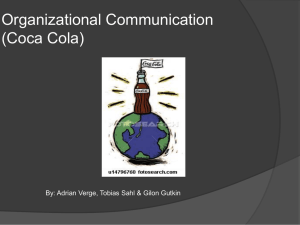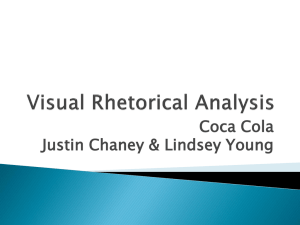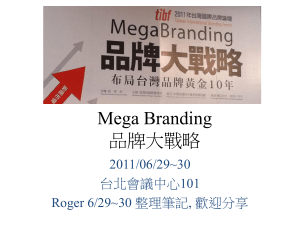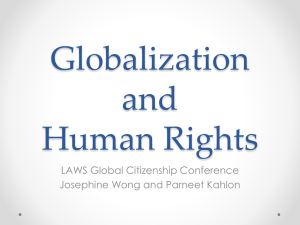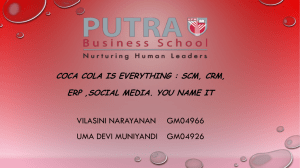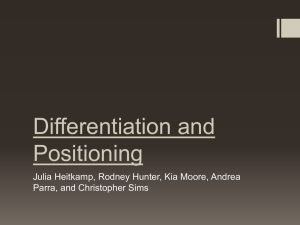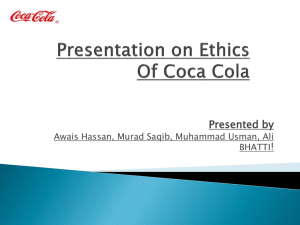coca cola – working internationally
advertisement
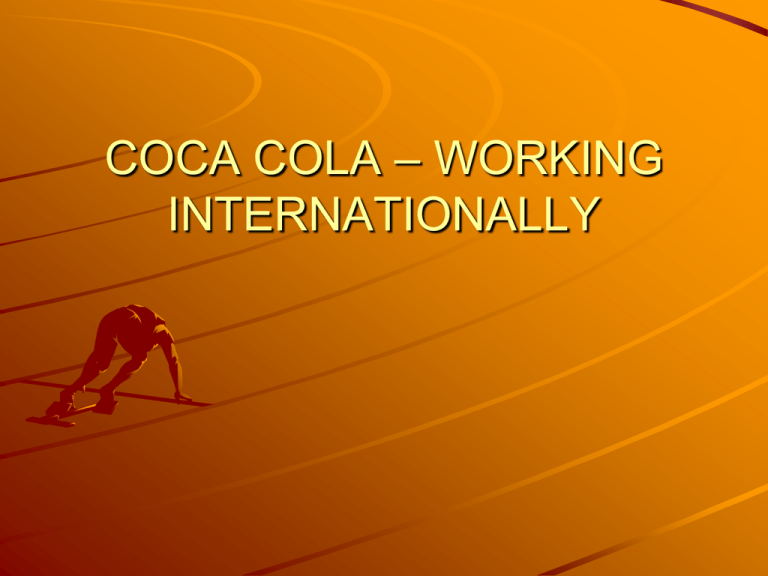
COCA COLA – WORKING INTERNATIONALLY Introduction Globalization poses many challenges in HR practices (McEnergy & DesHamais, 2003) HR practices varies from region to region Multinationals adapts practices that suits regions they operate (Zyman, 2009) Coca Cola – adopts regional HR practices Coca Cola Company Coca Cola is a leading beverage retailer, manufacturer, and marketer of different non-alcoholic beverage and syrups (Andrew, 2006) Best known for a leading brand in the world – Coca Cola The company has more than 500 brands It operates in more than 200 countries and serve 1.6 billion servings a day Cont.. Coca Cola syrup was invented in 1886 The formula was sold to Atlanta entrepreneur Asa Griggs in 1891 and the name Coca Cola was patented in 1893 By 1895, Coca Coal drink was sold in every state and territory in U.S By 1906, the company expanded to Cuba and Panama Cont… The performance of the company has been impressive over the years In 2005, the company sells beverage in more than 200 countries (Andrew, 2006) Of more than 50 billion beverage servings every day, the company account for 1.6 billion drinks everyday (The Coca Coal company ) The international market plays a major role in company performance Cont.. The following chart shows the company revenue by regions (The Coca Coal company ) : Coca Cola Perfomance by Regions United States 20% 43% 37% Mexico, India, Brazil, Japan & china Rest of the World International HR Practices Coca Cola adopts different HR practices as per region’s they operate The company does not have a standardized international HR practices Coca Cola HR policies are formed in compliance with local labor laws and culture Cultural diversity is key ingredient of its international operations (Mendenhall & Oddou, 2008) Job analysis and designing The company has globally standardized job structure (Anfuso, 2004) Job analysis and designing follows the same international structure Coca cola company checks job description and analysis The generated information is used in recruiting, compensation, appraisal, training and employee relationships Planning and forecasting Planning and forecasting involves deciding what positions the firm will have to fill and how to go about it (Palthe, 2009) Coca Cola HR company is involved in strategic planning HR department forecast future employee demand Forecast report is sent to regional head office for approval to start recruitment Recruitment Process Regional franchise have their own recruitment process once given go ahead to hire more employees The recruitment process is well established Job advertisements are placed in news papers, website, institutions and others The company carries both international and external recruitment Attention to culture Coca Cola pays close attention to local culture Special training given to employees on local and international culture New employees put under supervision of old employees (Briscoe et al., 2009) Working environment represent blend of different cultures (Werther & Chandler 2006) Employee motivation Motivated employees are important assets for a company (Ulrich, 2007) According to theories of motivation, monetary and non monetary factors remain key in motivating employees Coca Cola focuses on both monetary and non monetary factors Compensation The objective of company compensation is to improve performance of employees and convey a message that the company is loyal to employees The company gives may compensation – salary, bonus, medical, pick and drop, gratuity funds, social security etc Wages Research shows that monetary factors leads in motivating employees Coca Cola provides smart wages to employees (The Coca Cola Company, 2011a) Wages are competitive and satisfy employees Most employees by the company are offered competitive wages alongside commissions Staffing and Training The company has a clear staffing and training policy that is followed throughout its franchise (The Coca Cola Company, (2011b) Coca Cola believes that education is powerful force in employee motivation (The Coca Cola Company, 2011a) The company has helps people make their drams true It has innovative programs – student books, place of study, scholarships (HR Leader, 2011) Annual Leaves The company has different leaves structure that conform to local and international labor laws. The leave structure depends on position of employees as follows: Designation Allowed Leaves Supervisor 26 leaves pa Above supervisor 26 leaves pa Below supervisor 24 leaves pa Working Hours Time management is taken serious in the company Their work is divided in shift to enable the company meet high demand (Global Human Resources Management at Coca Cola) Shifts are adapted to the local labor laws There are typical two shifts: 8 am to 4 pm 4 pm to 12 am Performance appraisal Appraisal of employees involves an assessment of employee performance Coca cola performs performance appraisal annually The company performance appraisal is internationally acclaimed and has three process a. Define job b. Appraise the performance c. Provide feedback Employee Relations Coca Cola considers employees as the greatest asset for the company Employee satisfaction translate to success for the company Internationally, the company adopts an open door policy to nurture good relationship Employees feel free to share with management about their problems Conclusion Working internationally is challenging for any company (Ashamalla, 2008) Coca Cola company is among the most successful multinationals The success of the company can be attributed to good HR practices The company follows international HR practices that are adopted to the local conditions References Andrew, Y (2006). An Easy Burden. HarperCollins Anfuso, D. (2004). Coca Cola’s staffing philosophy supports its global strategy. Personnel Journal 116-121 Ashamalla, M. (2008). International human resource management practices: The challenges of expatriation. CR 8, (2), 54 Briscoe, D., Schuler, R. & Claus, L. (2008). International human resource management. Routledge: London Global Human Resources Management at Coca Cola. Retrieved May 25, 2011, from http://www.work-a-holic.narod.ru/hr3.html HR Leader, (2011). Talent management at Coca Cola: the fizz from within. Retrieved May 25, 2011, from http://www.humanresourcesmagazine.com.au/articles/ed/0c053eed.asp itim international, (2011). Geert Hofstede cultural dimensions. Retrieved May 25, 2011, from http://www.geert-hofstede.com/ McEnergy, J. & DesHamais, G. (2003). Culture shock. Training and Development, 43-46 Mendenhall, M. & Oddou, G. (2008). Dimensions of expatriate acculturation. Human Resources Management, 331-345 Palthe, J. (2009). Managing human rights and human resources: the dual responsibility of global corporations. Western Michigan University The Coca Cola Company, (2011a). Workplace/workplace rights policy. Retrieved May 25, 2011, from http://www.thecoca-colacompany.com/citizenship/workplace_rights_policy.html The Coca Cola Company, (2011b). Diversity education & training. Retrieved May 25, 2011, from http://www.thecoca-colacompany.com/citizenship/education_training.html The Cocal Coal company http://www.thecoca-colacompany.com/ourcompany/index.html Ulrich, D. (2007). Human resource champions. Harvard Business School Press Werther, W. & Chandler, D. (2006). Strategic corporate social responsibility. Sage Publications Zyman, S. (2009). The End of Marketing as We Know It. New York: Harper Business.
